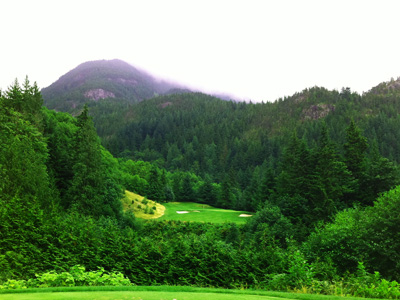UNIVERSITY PLACE, Wash. — Chambers Bay was born to host the U.S. Open.
The dream, the concept of holding an Open here was why the idea of turning an exhausted, century-old gravel pit into a quirky, championship-caliber course was conceived over a decade ago. This week, eight years after this ambitious project opened its doors to the world, it fulfills its destiny.
Chambers Bay — so named for a prominent 19th century family that settled in this area less than an hour south of Seattle — was imagined at the turn of the century by Pierre County (Wash.) County Executive John Ladenburg. The prospect of a golf course solved a few problems for Ladenburg. It would turn an otherwise useless piece of land into a valuable source of county cash flow, and it would, Ladenburg hoped, lure scores of tourists that might otherwise head to Oregon’s Bandon Dunes for a golf getaway. Were the conceptual course to someday score an Open, then the gamble would be worth it, paying off for decades.
Ladenburg had to get the county and his constituents to agree to his vision without exactly knowing what kind of course they would have to build to get on the U.S. Golf Association’s radar. After all, to that point, no course in the Pacific Northwest had ever held the national championship.
However, Ladenburg knew three things worked in his favor: the 250-acre plot on which Chambers Bay now sits was all sand, making drainage easy, and the climate was similar to Bandon, which the USGA and now executive director Mike Davis adore. The last edge? This course would be county-owned and wholly open to the public. It would be the Bethpage of the Northwest, the Torrey Pines up the Pacific coast.
The idea, even if the ultimate goal sounded far-fetched at the time, was sold well. Chambers Bay, initially referred to as Chambers Creek, would be built. Ladenburg landed on architect Robert Trent Jones Jr. to build his course and construction began in 2006. There were problems from the start.
The original $ 13 million budget was blown out of adjacent Puget Sound. In the end, it took $ 8 million more to finish the job. Money was no object. For better or worse, Ladenburg had issued a blank check on his constituents’ dime to make his dream a reality.
The fine fescue grass — a sustainable, water-stingy strain — that covers the course didn’t grow in as well as expected.
There wasn’t enough money for a clubhouse. There still isn’t a permanent one. In some sense, that simplicity represents the windswept Scottish links that inspired Ladenburg. In another, at over $ 200 per round ($ 300 for non-county residents) and now a major championship venue that lacks a standard amenity, there should be some place to change your shoes other than a trailer.
The county has had trouble meeting its debt obligations to pay back the millions it borrowed to build this Field of Dreams. In the last couple of years, as the Open has drawn closer, the volume of rounds has increased but the county and USGA have limited play in the 18 months leading into the championship. When the Open leaves town, the county expects the bucks to roll in.
However, for Ladenburg, all of those complications, ones he had to answer for politically in a failed 2008 attorney general campaign, gave way to a fortuitous opportunity. The 2010 U.S. Amateur was supposed to go to Congressional in the D.C. suburbs, a primer for hosting the U.S. Open the next year. When Congressional’s green renovation project hit a major snag — one that also doomed the quality of the Open setup that Rory McIlroy obliterated — they had to bow out of the Amateur. With Chambers complete and on the USGA’s watch list for an overdue Open foray in the Northwest, the barely open course had been given an invitation to host the 2010 Amateur and the 2015 U.S. Open, an invitation Winged Foot rejected in the wake of a minor member mutiny after their last turn at the Open in 2006.
So here we are, on a former rock mine at the end of a two-lane residential street, with the world’s best gathered for golf’s toughest major challenge.
It all doesn’t make sense.
The U.S. Open, a national championship in name but not with pins on the map, has never been in this part of the country. It’s never been contested on a course quite like this. A relatively new course hasn’t decided the U.S. Open in 45 years, since Hazeltine in 1970.
Chambers Bay is a different taste compared to the slices of municipal golf that are San Diego’s endearing Torrey Pines, with its incredible ocean views, and Long Island’s Bethpage Black, so tough it inspires a masochistic pride in its players. However, the views and design match its story: stunning and breathtaking.
Now, hopefully, this true one-off delivers a one-of-a-kind Open.
Ryan Ballengee is a Yahoo Sports contributor. Find him on Facebook and Twitter.
Follow @RyanBallengee
Devil Ball Golf – Golf – Yahoo Sports
Other Related Posts:
Tiger Woods and Lon Hinkle don't have much in common. One owns 14 major ch...
The Wyndham Championship was supposed to be all about the FedEx Cup -- a &...
You'd never really get how fun Jason Dufner can be by watching him play go...
The greatest Canadian hope to end a 61-year drought at their national champ...
Dustin Johnson, Danny Willett, and Henrik Stenson. (Getty) SPRINGFIELD, N.J...
















